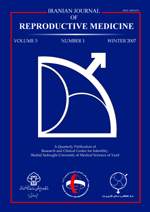
|
International Journal of Reproductive BioMedicine
Research and Clinical Center for Infertility, Shahid Sadoughi University of Medical Sciences of Yazd
ISSN: 1680-6433
EISSN: 1680-6433
Vol. 16, No. 6, 2018, pp. 417-420
|
 Bioline Code: rm18048
Bioline Code: rm18048
Full paper language: English
Document type: Case Report
Document available free of charge
|
|
|
International Journal of Reproductive BioMedicine, Vol. 16, No. 6, 2018, pp. 417-420
| en |
Granulosa-cell tumor after ovarian stimulation: A case report
Yousefi, Zohreh; Khalilifar, Hekmat; Jafarian, Amir Hosein; Davachi, Behrouz; Seresh, Leila Mousavi; Babapour, Nooshin; Shirinzadeh, Laya & Baradaran, Mina
Abstract
Background: Ovarian superovulation and increased follicle-stimulating hormone
concentration for infertility treatment may be the risk factors of developed
granulosa-cell tumor. The aim of this report is to introduce a case of granulosa-cell
tumor which was discovered after ovarian stimulation.
Case: A 31-yr-old woman with clinical presentation of massive abdominal
distention was referred to the gynecology and oncology department of an academic
hospital, Mashhad University of Medical Sciences in Aug 2017. She had the history
of secondary infertility and was undergoing In Vitro Fertilization protocol and
ovarian stimulation, but, the cycle was canceled. The patient suffered from gradual
abdominal distention one month after the end of IVF procedure despite pregnancy
failure. 2-3 months after management of the ovarian hyperstimulation syndrome,
investigation revealed large ovarian mass and increased tumor marker inhibin.
Exploratory laparotomy was performed and revealed stage III ovarian cancer. The
final pathology report indicated juvenile granulosa cell tumor. So, optimal surgical
staging and cytoreductive surgery without fertility preserving were perfumed.
Chemotherapy was recommended due to the advanced stage of ovarian cancer.
Unfortunately, she experienced metastatic diseases in pelvic and abdomen in less
than six months; and currently is receiving the second and third line chemotherapy.
Conclusion: Persistent ovarian enlargement or ascites during or after infertility
treatment should be carefully considered and managed.
Keywords
Ovarian stimulation; Granulosa-cell tumor; Ovarian cancer.
|
| |
© Copyright 2018 - International Journal of Reproductive BioMedicine
Alternative site location: http://www.ijrm.ir
|
|
